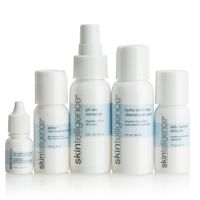Detoxify, wind down and rejuvenate.
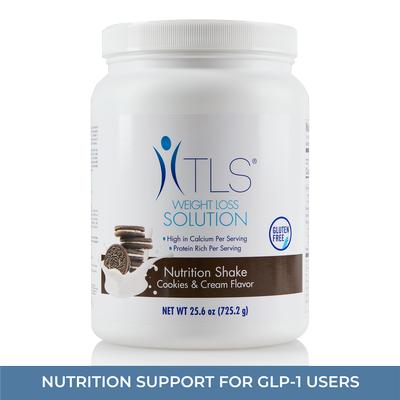
TLS® Nutrition Shakes - Cookies & Cream
sku 6422
$43.95
$ 0.88 Cashback
This product qualifies for free or reduced cost shipping. Learn More
Primary Benefits* of TLS® Nutrition Shakes - Cookies & Cream
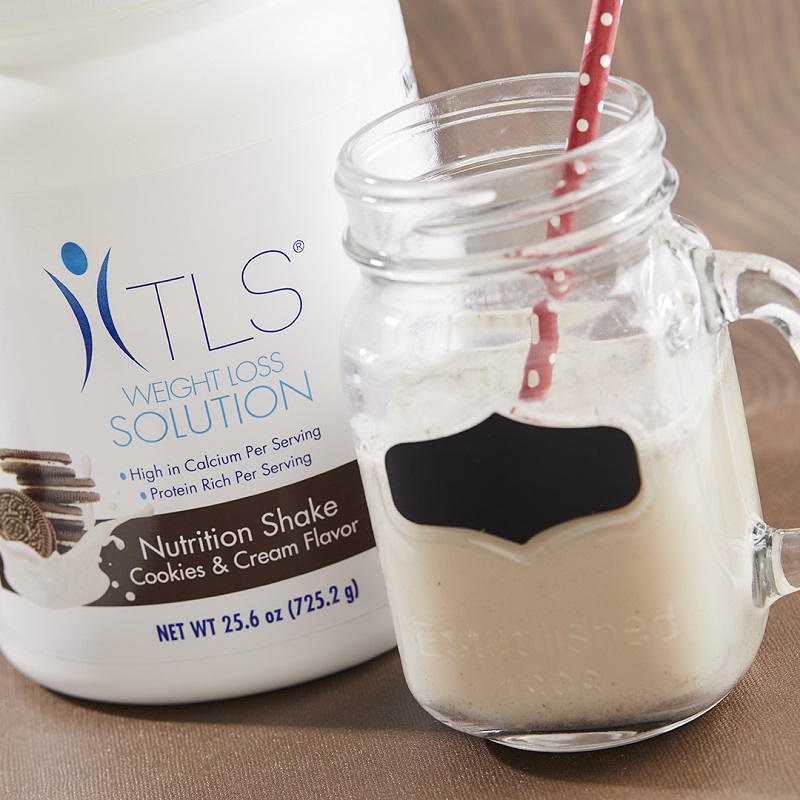
- Provides 18 grams of protein per serving
- Provides 10 grams of fiber per serving
- Provides 24 essential vitamins and minerals per serving
- No added sugar
- Great taste
Learn More
What Makes TLS® Cookies and Cream Nutrition Shake Unique?
Indulge with our delicious new TLS® Cookies & Cream Nutrition Shake. This shake is smooth and delightful and is sure to be your new favorite. Just like our other popular Nutrition Shakes, it is formulated to deliver superior flavor, texture, and satiety. With a balance of 18 g of protein, 10 g of fiber, and the essential vitamins and minerals in every serving, the TLS® Cookies & Cream Nutrition Shake is a convenient and delicious snack or occasional meal replacement that will help keep you going.
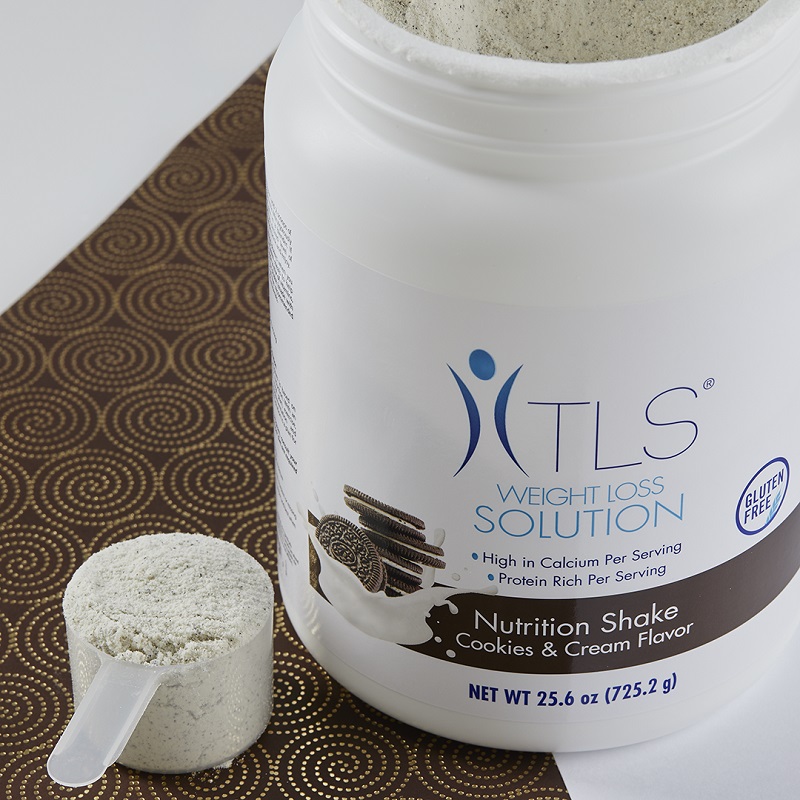
Product Classifications
Gluten-Free - The finished product contains no detectable gluten (<10ppm gluten)
Drinkable Supplements - Easy-to-swallow supplements in liquid form are immediately available to the body for absorption
Quality Standards - GMP Operations and Standardized Ingredients
Checked For: Heavy Metals, Microbiological Contaminants, Allergens, Residual Solvents, Potency, Purity and Identity
Key Ingredients
Protein (Whey, Pea Protein Isolate)
Protein is an important component of every cell in the body. Your body uses protein to build and repair tissues, as well as produce enzymes, hormones, and other body chemicals. Protein is an important building block of bones, muscles, cartilage, skin, and blood. Unlike fat and carbohydrates, the body does not store protein and, therefore, has no reservoir to draw on when it needs a new supply.
Clinical studies consistently show that high-protein diets increase satiety and decrease hunger compared with high-fat or high-carbohydrate diets. In addition, studies show that people on high-protein diets tend to reduce their overall caloric intake.
Protein also helps maintain lean tissue while burning fat for fuel and helping you maintain a feeling of fullness longer.
Vitamin A
Vitamin A is a fat-soluble vitamin. Sources of vitamin A include organ meats (such as liver and kidney), egg yolks, butter, carrot juice, squash, sweet potatoes, spinach, peaches, fortified dairy products and cod liver oil. Vitamin A is also part of a family of compounds, including retinol, retinal and beta-carotene. All the body’s tissues use vitamin A for normal growth and repair.
Vitamin C
Vitamin C is found in peppers (sweet, green, red, hot red and green chili), citrus fruits and brussels sprouts, cauliflower, cabbage, kale, collards, mustard greens, broccoli, spinach, guava, kiwi fruit, currants and strawberries. Nuts and grains contain small amounts of vitamin C. It is important to note that cooking destroys vitamin C activity. The body does not manufacture vitamin C on its own, nor does it store it. Therefore, vitamin C must be acquired through diet.
Thiamin
Thiamin plays an important role in carbohydrate metabolism and supports a healthy nervous system.
Vitamin B12
Vitamin B12 is naturally found in meats, liver, beef, pork, eggs, whole milk, cheese, whole wheat bread and fish. Vitamin B12 is almost exclusively found in animal products, with small amounts derived from fermented soy products such as miso and tempeh, and peanuts. Vitamin B12, when ingested, is stored in the liver and other tissues for later use. Vitamin B12 supports energy levels as it plays a vital role in the Krebs energy cycle.
Riboflavin (Vitamin B2)
Riboflavin, sometimes known as vitamin B2, is found in the liver, dairy products, dark green vegetables, and some types of seafood. It serves as a co-enzyme working with other B vitamins and aids in the breakdown of fats while functioning as a cofactor or helper in activating vitamin B6 and folic acid. The riboflavin coenzymes are also important for the transformation of vitamin B6 and folic acid into their active forms and for the conversion of tryptophan into niacin. Riboflavin plays a crucial role in turning food into energy as a part of the electron transport chain, driving cellular energy on the micro-level. Riboflavin is water-soluble and cannot be stored by the body except in insignificant amounts; thus, it must be replenished daily.
Pyridoxine HCl (Vitamin B6)
Poultry, fish, whole grains and bananas are the main dietary sources of vitamin B6. Vitamin B6 is required for hemoglobin synthesis and supports a healthy nervous system.
Vitamin D3
Regular sunlight exposure is the main way that most humans get their vitamin D. Food sources of vitamin D are vitamin D-fortified milk (2.5 mcg per cup), cod liver oil, and fatty fish such as salmon. Vitamin D promotes the absorption of calcium and phosphorus and supports the production of several proteins involved in calcium absorption and storage.
Vitamin E
The most valuable sources of dietary vitamin E include vegetable oils, margarine, nuts, seeds, avocados and wheat germ. Safflower oil contains large amounts of vitamin E and there are trace amounts in corn oil and soybean oil. Vitamin E is actually a family of related compounds called tocopherols and tocotrienols. The main health benefit of supplemental vitamin E comes from its immune-boosting antioxidant activity. It also promotes cardiovascular health. Vitamin E is one of the most powerful fat-soluble antioxidants in the body.
Calcium
The highest concentration of calcium is found in milk. Other foods rich in calcium include vegetables such as collard greens, Chinese cabbage, mustard greens, broccoli, bok choy and tofu. Calcium is an essential mineral with a wide range of biological roles. In bone, calcium accounts for approximately 40 percent of bone weight. The skeleton has a structural requisite and acts as a storehouse for calcium.
Magnesium
Foods rich in magnesium include unpolished grains, nuts and green vegetables. Green leafy vegetables are potent sources of magnesium because of their chlorophyll content. Meats, starches, dairy products, and refined and processed foods contain low amounts of magnesium. Recent research shows that many people’s diets are deficient in magnesium. The average daily magnesium intake in the U.S. for males is estimated to be about 323 milligrams; for females, it is estimated to be around 228 milligrams.1 Both are considerably less than the RDA of 400 and 310 milligrams, respectively.
Magnesium is a component of the mineralized part of bone and is necessary for the metabolism of potassium and calcium in adults. It is also important for the mobilization of calcium, transporting it inside the cell for further utilization. It plays a key role in the functioning of muscle and nervous tissue. Magnesium is necessary for the synthesis of all proteins, nucleic acids, nucleotides, cyclic adenosine monophosphate, lipids and carbohydrates.
Potassium
Foods rich in potassium include fresh vegetables and fruits such as bananas, oranges, cantaloupe, avocado, raw spinach, cabbage and celery. Potassium is an essential macromineral that helps to keep fluid balance. It also plays a role in a wide variety of biochemical and physiological processes. Potassium is important in releasing energy from protein, fat, and carbohydrates during metabolism.
Selenium
The best dietary sources of selenium include nuts, unrefined grains, brown rice, wheat germ, and seafood. In the body, selenium functions as part of an antioxidant enzyme called glutathione peroxidase as well as promoting normal growth and proper usage of iodine in thyroid functioning. Selenium also supports the antioxidant effect of vitamin E and is often added to vitamin E supplements.
Zinc
Zinc is largely found in fortified cereals, red meats, eggs, poultry and certain seafood, including oysters. It is a component of multiple enzymes and proteins. It is also involved in the regulation of gene expression. Zinc is an essential trace mineral that has functions in approximately 300 different enzyme reactions. Thus, zinc plays a part in almost all biochemical pathways and physiological processes. More than 90 percent of the body’s zinc is stored in the bones and muscles, but zinc is also found in virtually all body tissues.
Biotin
Biotin can be found in food sources such as egg yolks, peanuts, beef liver, milk (10 mcg/cup), cereals, almonds and Brewer’s yeast. Biotin is used for cell growth, the production of fatty acids, metabolism of fats and amino acids. It plays a role in the citric acid cycle, which is the process in which biochemical energy is generated during aerobic respiration. Biotin not only assists in various metabolic chemical conversions but also helps to transfer carbon dioxide.
1 Office of dietary supplements - Magnesium. (n.d.). Retrieved March 02, 2021, from https://ods.od.nih.gov/factsheets/Magnesium-HealthProfessional/
FAQs
What does the TLS® Cookies & Cream Nutrition Shake taste like?
The new TLS® Cookies and Cream Nutrition Shake has the perfect combination of vanilla and cookie flavor that helps to satisfy cravings without being too sweet. It has a smooth texture, no after-taste and it mixes quickly with water or your favorite type of milk in a shaker bottle for easy on-the-go option. It can also be mixed in a blender with ice, fruit, or your other favorite additions to make a smoothie. You will love this new limited-edition, so get yours today.
Is the TLS® Cookies & Cream Nutrition Shake vegetarian?
Yes. The TLS® Cookies & Cream Nutrition Shake only utilizes whey and pea protein isolates. Whey protein is derived from milk, and pea protein isolate is a plant-based source of protein.
How often should I have a TLS® Cookies & Cream Nutrition Shake?
The TLS® Cookies & Cream Nutrition Shake is especially useful as a snack between meals to help fight hunger and provide additional protein, fiber, and calcium. They can be enjoyed anytime.
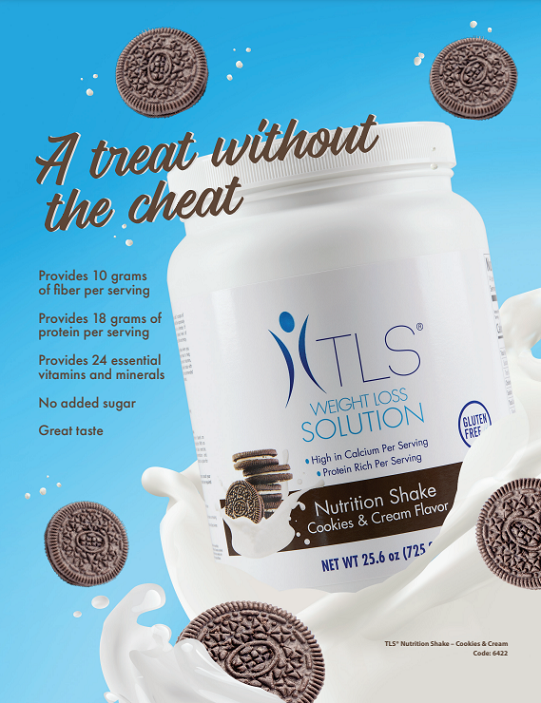
Science
- Blomstrand E, et al, Branched-chain amino acids activate key enzymes in protein synthesis after physical exercise. J Nutr 136, (1 Suppl): 269S-73S (2006)
- Burke, G, et al, The effect of whey protein supplementation with and without creatine monohydrate combined with resistance training on lean tissue mass and muscle strength. Int J Sport Nutr Exerc Metab 11, 3:349-64 (2001)
- Douglas Paddon-Jones, Eric Westman, Richard D Mattes, Robert R Wolfe, Arne Astrup, Margriet Westerterp-Plantenga, Protein, weight management, and satiety, The American Journal of Clinical Nutrition, Volume 87, Issue 5, May 2008, Pages 1558S–1561S, https://doi.org/10.1093/ajcn/87.5.1558S
- Halton, T., & Hu, F. (2004). The effects of high protein diets on thermogenesis, satiety and weight loss: A critical review. Journal of the American College of Nutrition, 23, 373-385. doi: 1080/07315724.2004.10719381
- Nielsen FH. Ultratrace minerals. In: Shils ME, Olson JA, Shike M, Ross AC, eds. Modern Nutrition in Health and Disease, 9th ed. Baltimore, MD: Williams and Wilkins; 1999:283-303.
- Nishi Y. Anemia and zinc deficiency in the athlete. J Am Coll Nutr. 1996 Aug;15(4):323-4.
- Office of dietary supplements - Magnesium. (n.d.). Retrieved March 02, 2021, from https://ods.od.nih.gov/factsheets/Magnesium-HealthProfessional/
- Ortinau, L.C., Hoertel, H.A., Douglas, S.M. et al.Effects of high-protein vs. high- fat snacks on appetite control, satiety, and eating initiation in healthy women. Nutr J 13, 97 (2014). https://doi.org/10.1186/1475-2891-13-97
- Pesta DH, Samuel VT. A high-protein diet for reducing body fat: mechanisms and possible caveats. Nutrition & Metabolism. 2014 ;11(1):53. DOI: 10.1186/1743-7075-11-53.
- Rennie MJ, et al, Branched-chain amino acids as fuel and anabolic signals in human muscle. J Nutr 136, (1 Suppl): 264S-8S (2006)
- Shimomura Y, et al, Exercise promotes BCAA catabolism: effects of BCAA supplementation on skeletal muscle during exercise. J Nutr 134, (6 Suppl): 1583S-1587S (2004)
- Tipton KD, et al, Ingestion of casein and whey proteins result in muscle anabolism after resistance exercise. Med Sci Sports Exerc 36, 12:2073-81 (2004)
- Tokunaga K and Matsuoka A, Effects of a [FOSHU] which contains indigestible dextrin as an effective ingredient on glucose and lipid metabolism," J Japanese Diabetes Society , 42:61-65, 1999.)
- S. Department of Agriculture, Agricultural Research Service. Usual Nutrient Intake from Food and Beverages, by Gender and Age, What We Eat in America, NHANES 2013-2016; 2019.
- Weaver CM, Heaney RP. Calcium. In: Shils ME, Olson JA, Shike M, Ross AC, eds. Modern Nutrition in Health and Disease. 9th ed. Baltimore, MD: Williams and Wilkins; 1999:141-155.
Reviews
Displaying 1 - 5 of 26
03/05/2025
by GwendolynJ
Cookies and Cream Flavor Shake
The taste is great!! It's very smooth and creamy!! Easy to prepare!!
Personally, I don't care for this flavor because it tastes too sweet to me. But, if anyone has a sweet tooth, this is the perfect flavor.
Response from Customer Service
03/05/2025
Thank you for sharing your experience with TLS® Nutrition Shakes - Cookies & Cream! It's wonderful to know that you enjoyed the smooth and creamy texture and found it easy to prepare. We understand that sweetness levels can vary in preference, and we appreciate your honest feedback. It’s great to hear you'd recommend it to those with a sweet tooth. Your insights are incredibly valuable to us, and we're grateful for the opportunity to learn from your perspective. Thank you for choosing our product!
10/21/2024
by TyneshaS
TLS Shakes: My Key to Losing Over 100 Pounds!
TLS Shakes are the best-tasting shakes I’ve ever tried! They’ve been life-changing for me. After struggling with my weight for over a decade at 435 pounds, these shakes helped me lose over 100 pounds and break through a long plateau. I finally hit the 300-pound mark, a milestone I thought was impossible. They keep me full and make it easy to stay on track. If you're looking for a shake that’s more than a quick fix, I highly recommend TLS Shakes. They changed my life, and they can help you too!
Response from Customer Service
10/22/2024
Thank you so much for sharing your incredible journey with TLS® Nutrition Shakes - Cookies & Cream! We're thrilled to hear how they've played a role in your amazing transformation and helped you reach such an important milestone. It's wonderful to know they're not only delicious but also support your lifestyle. Your inspiring story is truly appreciated, and we're honored to be part of it. Thank you for recommending TLS Shakes!
06/14/2024
by NicoleS
Not very good
This nutrition shake is edible, but it tastes very chalky. I will not be being it again and wish I had bought the Chocolate Delight instead. Don't waste your money on this one!!!
Response from Customer Service
06/14/2024
Dear Valued Customer,
We're sorry to hear that our TLS® Nutrition Shakes - Cookies & Cream didn't meet your expectations. We truly appreciate your honest feedback and understand that taste preferences can vary greatly among individuals.
We understand taste and texture can be subjective. And yes, as you mentioned, trying our Chocolate Delight variety could provide a different experience that may be more enjoyable for you.
Meanwhile, to potentially enhance your current Cookies & Cream shake experience, many customers have found success in adding fruit, like bananas or strawberries, into their shakes. This not only adds a burst of flavor but can alter the consistency which might help to minimize any chalky texture you're experiencing.
Again, we appreciate you taking the time to share your thoughts and we hope our suggestion might help improve your experience.
Thank you again,
The Product Information Team
02/04/2024
by KendallM
Not as good as the other flavors
Excited to try this flavor after sticking with vanilla and chocolate, but both my husband and I disliked the flavor to the point we don’t want to drink it. I do only mix with water and not milk, but that is just fine with the other flavors.
Response from Customer Service
02/05/2024
Dear Valued Customer,
Thank you for sharing your feedback on TLS® NUTRITION SHAKES - COOKIES & CREAM! We appreciate your honesty. If you decide to give it another try, you might find it helpful to mix it with milk instead of water for a potentially different taste experience. Additionally, blending it in a blender can enhance the texture and flavor. If you have any more comments or need further assistance, please feel free to reach out. We value your input and hope you find a combination that suits your taste preferences.
Thank you again,
The Product Information Team
05/24/2023
by CarolP
Just what the doctor ordered!
My husband's oncologist suggested that he try to drink protein shakes to help boost his energy while he is undergoing chemotherapy. We researched the drinks that they had given him in the hospital and those that others had recommended and the TLS shakes had more protein and fiber and less sugar. So he has been drinking them and they have helped with his energy!
Response from Customer Service
05/25/2023
Dear Valued Customer,
Thank you for taking the time to share your thoughts on the TLS® Nutrition Shakes - Cookies & Cream! We are so happy to hear you are pleased with the product!
Thank you again!
The Product Information Team
- Prev
- Next

